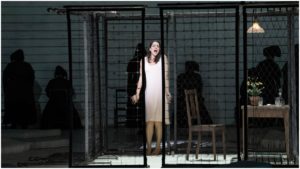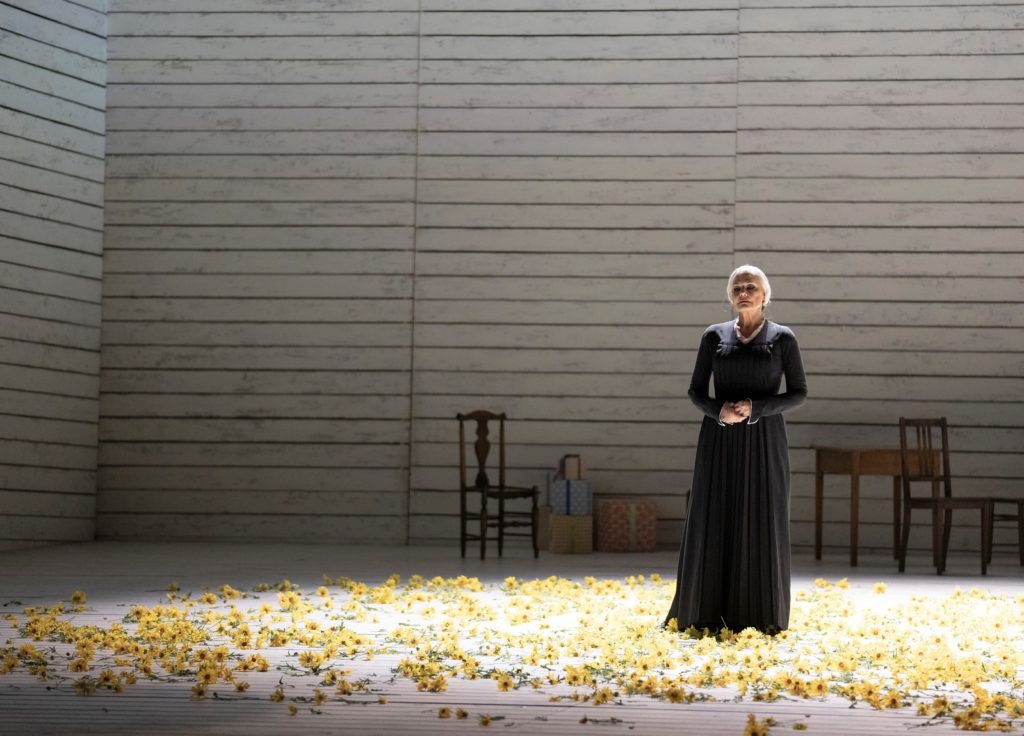
Royal Opera House 2021-22 Review: Jenůfa
A Taut and Intensive New Production from Claus Guth in London
By Benjamin Poore((c) ROH 2021)
The Royal Opera House’s first new production of Leoš Janáček’s “Jenůfa” in over twenty years was one of the first casualties of the 2020 lockdown, shelved on the cusp of opening in March that year. A starry cast made it an especially hot ticket then, especially given the involvement of imaginative German director Claus Guth, and they are (with a couple of exceptions) now reunited for a psychologically incisive and richly-sung realization of this emotionally searing work. The libretto is the composer’s own, but after Gabriel Preissova’s “Její pastorkyňa,” a story of Moravian infanticide and weak, hypocritical men – exactly the kind of acidic satire Janáček found himself drawn to repeatedly.
A Highly Anticipated Production
Guth dispenses with realism, though costumes and props remain in the nineteenth century. The mill and the village are gone in favor of a spare off-white space, to the rear and sides of which we see the toil and routine of everyday village life play out (men and women come and go, identically dressed). The back wall hosts video projections in Act two (from duo rocafilm) – stars as Jenůfa prays for her baby, a flurry of snow, sometimes the tangled shapes of her wire prison. In Act three the vast empty space of the stage is strewn with flowers, and characters pose against the far wall, unmoving, as if in old photographs, which gives the scene an alienated coldness; Jenůfa and Laca sit with their backs to us, seemingly a world away from everyone else.
The blocking is simple but serves the right emotional beats; Guth has brilliantly captured the opera’s complex inwardness and Freudian intensities. Dancers appear in Act one to celebrate Števa being passed over for military service, hoisting and pulling a disengaged, frustrated Jenůfa around – even the breaks in routine that a party brings are just another way of going through the grim motions of the town, which offer little nourishment for its women. As the Kostelnička explains the dangers of drunks like Števa, a vision of her own deceased and violent husband is acted out in parallel with Števa’s own preponderance for cruelty.
This is relatively tame stuff from the man who set “La bohème” on the moon. But Guth’s clarity of vision allows the symbolic and psychological register of the opera to cut through, as well as the emotional rawness essential to Janáček’s dramas.
There is a precision and economy to the stage pictures that capture the ritual that Guth sees at the heart of the work. The men and women of the town act out their habitual comings and goings in identikit formation as Act one unfolds, in regimented rows of beds across the rear of the stage that summons both the provincial workhouse and barrack. The bed frames become a wire cage in which Jenůfa is locked away with her baby in Act two; the mattresses piled up as if crags of frozen winter ice – images that grasp the emotional sterility and patriarchal capture of Jenůfa and the Kostelnička’s lives. As the latter resolves to kill Jenůfa’s baby, she is stalked by a crow-like figure wearing a terrifying headdress, as if from some arcane ritual.
Is there some heavy-handedness here? Yes, to a degree – but it certainly beats the kind of bucolic clutter that directors too often turn to in staging the work. Choice details in design and costume provide thematic and emotional focus and stop it from running into an (equally undesirable) abstract wash. The women’s chorus in Act three wear glittering, bright country dresses – costumes by Gesine Völlm – whose colorful panels are stitched onto black fabric, evoking the grave corvids of Act two, but also Nicholas Roerich’s primordial costumes for “Le sacre du printemps”.
Each act opens with a semi-curtain made of wooden shutters, through which the light dances, and beyond which Jenůfa and Laca step in the final moments – as if breaking through the veil of shame, secrecy, and privation that are the iron laws of this community. It is a disarmingly understated ending that lets the radiant, revelatory music do the talking, as two wounded people walk with quiet dignity and humanity to face the audience, unashamed – as if to challenge our world to the same extremes of forgiveness and reconciliation that Janáček musters in the work. The striated designs and taut lighting of Michael Levine and James Farncombe owe much to the domestic installations of Mona Hatoum and Damian Ortega.
A Strong Cast
Nicky Spence is a Števa of considerable experience – he has also recorded Janáček’s song cycle “The Diary of one Who Disappeared” to considerable acclaim – but makes his role debut as Laca. He is a brightly-voiced tenor with a lithe, tightly-wound voice that suits the tough registration and energetic text Janáček sets. But this is tempered by a surprising tenderness and soft-grained quality that grows as the opera goes on, in line with Laca’s own personal mellowing – quite different to the nasty and jealous man of the opening. Occasionally Spence sounded a little underpowered, but this may be owing to too much enthusiasm from the pit. But his warmth and pliability in the opera’s final scene – and his fervent defense of Jenůfa in the face of the mob just before – were profoundly moving.
Asmik Grigorian takes the title role, singing with verve and panache. Hers is a powerful instrument, with plenty of gleam and brilliant, though its resources are carefully marshaled across the show, its delicacy and warmth deployed generously. Jenůfa’s Act two prayer was – as always – a highlight, burning slowly towards its exultant climax. There is a crystalline clarity to her voice, whether loud or soft, that works especially well in the duets of this opera, whether with Spence or Karita Mattila’s Kostelnička – a still point of moral courage and ethical wisdom that cuts through the foibles of those around her.
Mattila’s Kostelnička was simply outstanding. With Guth’s help, she offers a remarkably sympathetic and necessarily complex characterization of a figure whose ruthlessness comes from the violence and viciousness she herself suffered; her guilt and shame are palpable in Act three, though never overdone, and her decision to kill Jenůfa’s baby feels like the culmination of a terrible fall rather than a moment of wickedness, however wicked it may be. Her voice is perfectly tailored to the role – there is a consistently velvety legato offset by moments of guttural despair, and its careworn, lived-in quality is the perfect foil to Grigorian’s glassy brightness. We have already surely seen one of the outstanding performances of the season.
Saimir Pirgu’s Števa was in clarion-voiced and full of vocal swagger, easily cutting the lush orchestral textures; his vocal bravado was offset by an Act two portrayal of a weak and fearful man, cut down to size by Kostelnička. Jacquelyn Stucker was a zesty and authentic Karolka, whose distress at learning about Števa’s failure is a brief though well-judged moment of human heartbreak; it is a microcosm of the excellent directing that underpins the show. David Stout’s Foreman is rugged and richly-toned – apart from the growled final line of Act one, where the lid feels like its about to come off the whole town. Elena Zilio puts in a fine turn as the grandmother.
Henrik Nánási led the action from the pit, drawing sumptuous playing from the ROH orchestra, and favoring the Romantic sweep rather than the modernist bite of Janáček’s score. There is no doubt the latter was wanting in a production as stringently stripped back as this, and alongside performances of such vocal intensity, particularly at the climax of Act two, which called for a whisker more ferocity.
Some balance issues meant occasionally occluded singing, in the cases of Grigorian and Spence at least, but these will surely be ironed out as the run goes on. And there were plenty of orchestral highlights. Vasko Vassilev’s violin solos in Act two touched the raw emotional nerves of the scene without lapsing into coarseness or crunchiness; the Act three dances had rhythmic impetus and rustic fun aplenty; and the xylophone-led danse macabre of the opera’s opening waltz was woozy and menacing by turns. An incisive and gripping performance of one of opera’s most complex tragedies – it should run and run.



